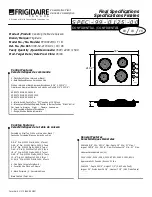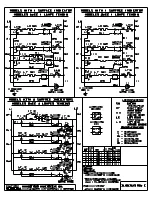
7
Lighting Burners
All burners are ignited by electric ignition. There are no open-flame, “standing” pilots.
Surface Burners-Automatic Reignition
To light the surface burners, push and turn the appropriate control knob counterclockwise to any position.
This control is both a gas valve and an electric switch. Burners will ignite at any “ON” position with the
automatic re-ignition system. If the flame goes out for any reason, the burners will automatically reignite if
the gas is still flowing. When gas is permitted to flow to the burners, the electric igniters start sparking. On
all surface igniters you should hear a “clicking” sound. If you do not, turn off the control and check that the
unit is plugged in and that the fuse or circuit breaker is not blown or tripped.
Note:
When opening or closing cabinet drawers or doors near the cooktop there may be a disturbance in the air supply causing the
burner flame to extinguish momentarily. The burner will relight with the automatic re-ignition system once the air supply stabilizes,
normally within a few seconds. This is not a safety or performance concern.
Rear, Center, and Front Burners
Push in and turn the control knob counter-clockwise to the desired setting. The control knobs can be turned to any desired setting as
the knobs do not have fixed positions between “Hi” and “Simmer”.
Within a few moments, enough gas will have traveled to the burner to light. When the burner lights, turn the burner control to any
position to adjust the flame size. Setting the proper flame height for the desired cooking process and selecting the correct cooking
vessel will result in superior cooking performance, while also saving time and energy.
Note:
The igniters may click a number of times before the burner ignites. This is normal. All igniters will spark regardless of which
burner is being operated.
Surface Operation
Operation
Surface Cooking Tips
•
The simmer line on the control panel is the beginning of the variable simmer setting and produces a high simmer setting. Turn the
knob slowly towards “OFF” and the flame will adjust to a lower simmer setting.
• Use low or medium flame heights when cooking in cookware that are poor conductors of heat, such as glass, and ceramic.
Reduce the flame height until it covers approximately 1/3 of the cookware diameter. This will ensure more even heating within the
cookware and reduce the likelihood of burning or scorching the food.
• Reduce the flame if it is extended beyond the bottom of the cookware. A flame that extends along the sides of the cookware is
potentially dangerous, heats the cookware handle and kitchen instead of the food, and wastes energy.
• Reduce the flame height to the minimum level necessary to perform the desired cooking process. Remember that food cooks just
as quickly at a gentle boil as it does at a rolling boil. Maintaining a higher boil than is necessary causes a loss in food flavor and
nutrients.
Surface Heat Settings*
*Note:
The above information is given as a guide only. You may need to vary the heat settings to suit your personal requirements.
Heat Setting
Use
Simmer
Melting small quantities
Steaming rice
Simmering sauces
Low
Melting large quantities
Med Low
Low-temperature frying (eggs, etc.)
Simmering large quantities
Heating milk, cream sauces, gravies,
and puddings
Med
Sautéing and browning, braising, and pan-frying
Maintaining slow boil on large quantities
Med High
High-temperature frying
Pan broiling
Maintaining fast boil on large quantities
High
Boiling water quickly
Deep-fat frying in large cookware






























